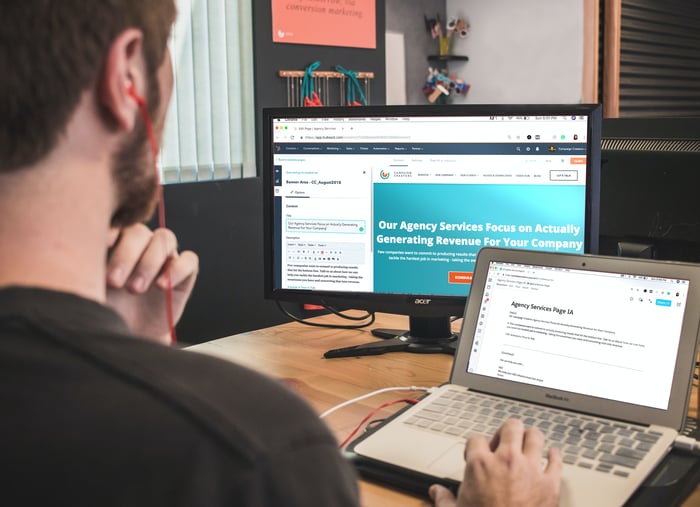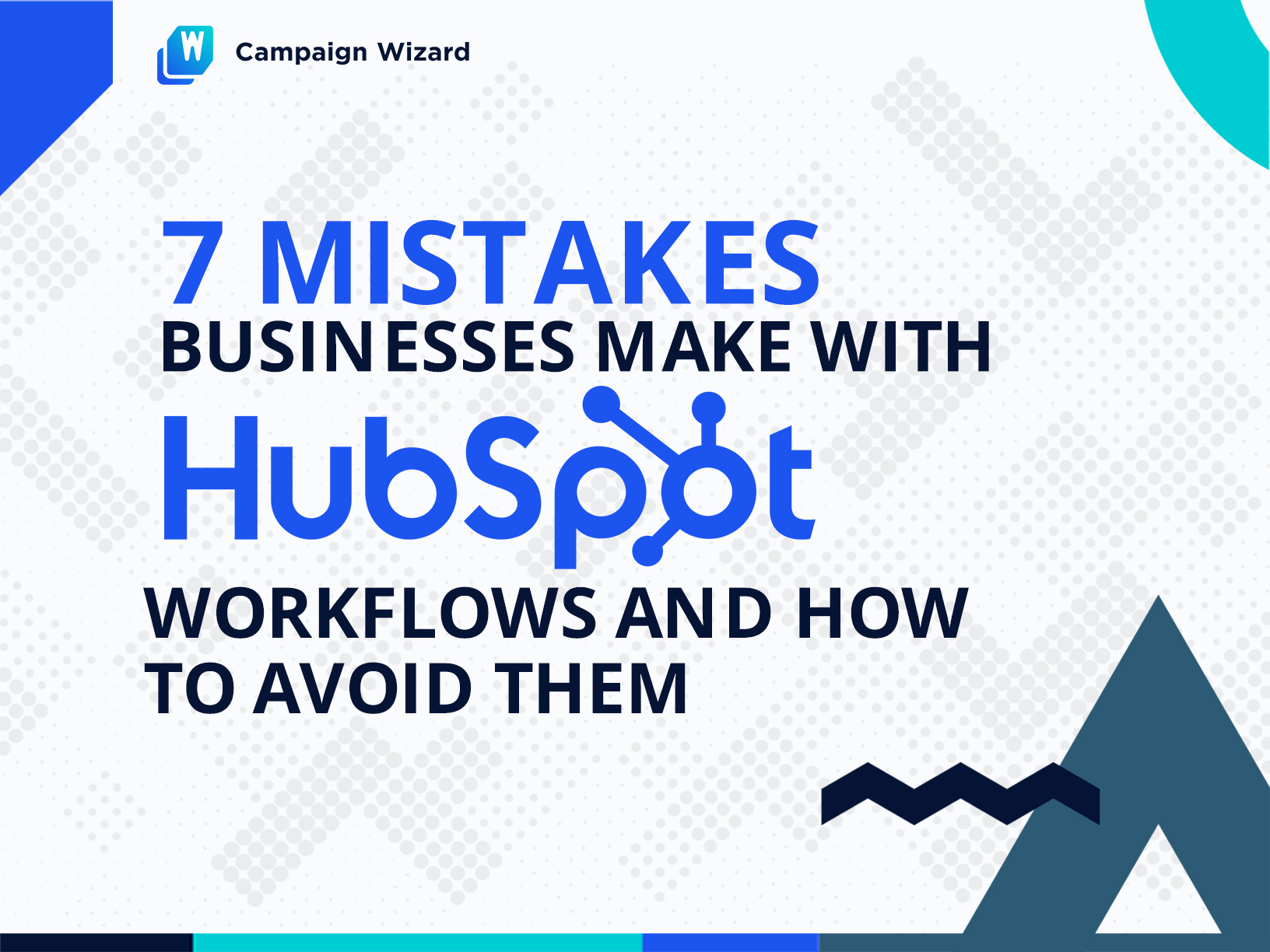Automating core marketing, sales, and service business operations is one of the key reasons businesses invest in an automation platform like HubSpot.
But to realize automation benefits (like higher productivity, reduced overheads, and simply better results) with HubSpot, you need to know how to create good HubSpot workflows, because it's workflows that power the platform's automation. Unfortunately, some HubSpot workflow mistakes are very easy to make.
So let's see what these most common HubSpot workflow mistakes are and how you can avoid them. But before that, let's zoom in on what HubSpot workflows are and see a few examples.
What Are HubSpot Workflows?
HubSpot workflows are automations that let you fully automate hundreds of your routine marketing, sales, and service processes. HubSpot's workflows use trigger events to execute actions (or sequences) automagically without needing your manual intervention.
For example, using HubSpot workflows, you can add email automation to your marketing mix and fully automate a big part of your email marketing. You can design a workflow — say, Lead Nurturing — to send a pre-specified set of emails to people who sign up on a specific landing page via a particular form on your website.
You can also automate email communications to your sales-qualified leads using another workflow. In the same way, you can design automatic email communications for trial signups as well.
Below, you can see how such email marketing automation happens via HubSpot's workflows:
Just like marketing processes, many of your sales operations can also be automated with HubSpot workflows. HubSpot workflows allow automated customer service, too.
HubSpot's marketing, sales, and service tools coupled with the platform's automation prowess help you move a big chunk of your day-to-day work forward without really doing any of it manually.
The best part is that once you create HubSpot workflows, they run on their own. If you want to use the platform effectively, you need to be fully conversant with creating workflows in HubSpot.
HubSpot Workflow Examples
Creating workflows in HubSpot becomes really easy when you understand the different entities the platform supports and their properties.
Take the Company entity, for example. HubSpot supports numerous properties like Industry, Lead status, and Lifecycle stage for it.
With HubSpot workflows, you can use a mix of these entities and properties and set up unique trigger events that trigger pre-set automatic processes. Let's take a look at a few HubSpot workflow examples to understand how this works.
HubSpot workflows based on changes to properties
HubSpot can detect changes to your entities' properties and roll out your workflows based on said changes. For example, if a company fills your demo signup form, they move to the consideration stage. Once your sales team changes the Lifecycle property of this company from "Lead" to "Opportunity," HubSpot can execute your conversion workflow.
Engagement/re-engagement HubSpot workflows
HubSpot can also see the status and activity of your entities to trigger your workflows. Such user behavior-based workflows offer meaningful nudges that help you convert more. For example, if you have a contact who visits your pricing website's page, HubSpot can detect this behavior and launch your workflow to engage the contact.
Lead scoring HubSpot workflows
You can also use HubSpot workflows to automate your internal marketing processes like lead qualification. By attributing positive and negative value to user actions, you can have HubSpot automatically adjust their lead scores so you can have an accurate picture of your sales pipeline at all times.
Lead nurturing HubSpot workflows
HubSpot workflows let you automate your lead nurturing, too. You can use workflows to automatically drip marketing communications (like emails, messages, and in-app alerts) to your leads and help them move forward in their buying journey.
HubSpot workflows for automatic notifications
With HubSpot workflows, you can easily streamline your internal marketing, sales, and service ops. For example, each time a new lead is acquired (like a webinar registrant), you can set a workflow to send a notification about it to your entire salesforce or only to a specific sales rep. You can also alert your sales reps if a lead moves from the demo stage to the trial stage.
With such internal notifications, your teams can streamline their work and better prioritize their activities for the day.
Event- and date-based HubSpot workflows
HubSpot workflows also offer end-to-end automation of event marketing campaigns like webinars. From registration emails to post-event marketing and sales follow-ups, HubSpot's event-based workflows are powerful business generation tools. You can also use the critical dates in your leads' journey to power your HubSpot workflows. For instance, you can set a workflow to start seven days after a lead does a demo session.

7 Most Common Mistakes Businesses Make With HubSpot Workflows
Despite how simple HubSpot makes building workflows look like, you actually need solid technical marketing skills to implement them.
Errors easily creep in.
Here, we’ll look at the seven most common HubSpot workflow mistakes that businesses make when setting up their automation. These elementary mistakes can thwart even the best-laid plans and marketing efforts, so being aware of them from the get-go can help you avoid problems down the line. . We'll also review HubSpot workflow best practices so you can understand what to do instead.

Setting overcomplicated workflows
The whole purpose of automation workflows is to put repetitive manual work on autopilot. For each repetitive task — like nudging a shopper to return to their abandoned cart and complete their purchase — a straightforward workflow suffices.
If you try to do more than realize one goal with a workflow, you'll find yourself doing deep if/then branching. In addition to being challenging to execute logically, nested workflows tend to be more error-prone.
So before creating workflows in HubSpot, draw them on a paper or whiteboard for a big-picture view of the flow. . Look for opportunities to optimize the workflows before adding them to HubSpot.
The more complex your workflows look on the board, the more difficult they will be to implement in HubSpot.
Remember that the best workflows are simple. You can implement a lot of your automations with basic if/then logic.
Not getting the timing right
Another very easy-to-make HubSpot workflow mistake is poor timing.
HubSpot workflows help you schedule your marketing, sales, and service "touches." Ideally, you want to deliver these touchpoints to your leads at just the perfect moment on their pre-and post-buying journey.
But creating workflows that deliver these touches at the right time, so they're the most effective, can be challenging.
So before scheduling your marketing, sales, or service experiences with HubSpot workflows, think about when the right time would be for delivering them:
- When should you send an upsell offer to a newly onboarded customer?
- How long should you wait before following up with a lead that needs to get back on your quote?
- When exactly would it make sense to ask a customer for a review on a third-party review website?
You get the idea.
You don't want to rush, but you certainly don't want to be too late with your outreach. With HubSpot workflows, you can be agile and respond to your customers based on their behavior. So factor in your users' interactions when codifying automatic processes in HubSpot.
Not defining clear workflow goals
HubSpot workflow goals hold the key to successful workflow implementation. They help you analyze your workflows' performance. For example, for a lead nurturing workflow, your goal might be to have the target contact's Lifecycle stage change to "Customer." Once a contact enrolled in your workflow advances to the customer status, they'll be automatically removed from the workflow as the goal has been achieved.
If you don't set your workflow goals correctly, your workflows won't know when to stop engaging a contact.
Failing to engage dormant contacts/leads
Many companies that set up HubSpot workflows only focus on pursuing "hot" leads. Naturally, this lets them invest their salesforce only with leads that are the most likely to convert.
This makes sense, but with HubSpot workflows, you can pursue both your high-quality and cold leads. With HubSpot workflows, you can follow up with your cold leads and the more unviable contacts without taking up any of your salesforce's bandwidth.
Ideally, you should design dedicated workflows to convert dormant leads. You'll be surprised to find opportunities from leads you'd never consider pursuing.

Failing to analyze workflows' performance and updating
While HubSpot workflows work on their own once you set them, they do need periodic reviewing.
When businesses don't analyze and update their workflows, they keep sticking to inefficient processes. This is so because, often when workflows don't perform well, the problem lies with the underlying processes and not with the workflows themselves.
So revisit your workflows about once a quarter and review their performance.
Failing to test new HubSpot workflows
Some of your crucial marketing, sales, and service KPIs rest on how well your HubSpot workflows work. For example, if your lead nurturing workflows don't work as intended, your marketing messages won't reach your leads at the right moment.
Erroneous sales workflows — that fail to help your sales reps prioritize their outreach and efforts, for instance — can work against you. Faulty service workflows can cost valuable accounts. That's why you need to test your workflows before pushing them live.
So enlist someone on your team who knows the workflows' goals and flow to test them. Ensure with this testing that your workflows work as intended. Everything should be tested, from the most minute things like replacing personalization tags with the user's details to confirming that a goal completion is registered when the user performs the intended task.
Develop a QA checklist and run each HubSpot workflow you build through it before launching.
Not making user experience the top priority
Whether you're handholding a B2B lead across their buying journey or nudging a subscriber to return to their abandoned shopping cart to complete their purchase, your HubSpot workflows are ultimately for offering better experiences to your users.
When you set up internal work automation with HubSpot's workflows, it's your team that should get a meaningful experience.
Poorly thought-out workflows can become a nuisance — think of a lead getting your emails even after opting out or getting all your emails twice or receiving all of them at once!
Bad workflows can also cost you business. If you end up setting erroneous re-enrollment workflows (enrolling the same users to different workflows), you can end up overwhelming your valid leads and lose them.
You don't just need to meticulously plan each action a workflow triggers from the user experience standpoint but also need to follow up on it with thorough testing.
When in Doubt, Ask the HubSpot Experts
When done right, HubSpot workflows can truly automate your business. But creating effective workflows — that actually save you time, cost, and effort — is both a time-consuming and resource-intensive exercise, especially for teams that don't have any in-house HubSpot expert.
If you're looking to get your HubSpot workflows right in the first go — or need to revisit them because they aren't as effective — consider one of our turnkey HubSpot campaign templates.
You can find Campaign Wizard in the HubSpot App Marketplace here. It's free to connect to your HubSpot portal and browse the offerings. Each product comes with every asset needed (workflows, email templates, landing page templates, forms, lists, etc) for rapid and pain-free launch.
Originally published August 2, 2021, updated August 25, 2021
Tags:
HubSpot
Workflows
Automation
.png)


